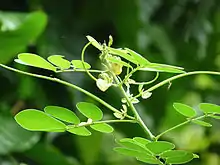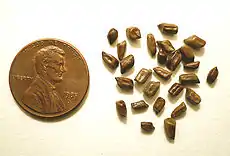Senna obtusifolia
Senna obtusifolia (Chinese senna, American sicklepod[1] or sicklepod) is a legume in the genus Senna, sometimes separated in the monotypic genus Diallobus. It grows wild in North, Central, and South America, Asia, Africa, and Oceania, and is considered a particularly serious weed in many places. It has a long-standing history of confusion with Senna tora and that taxon in many sources actually refers to the present species.
| Senna obtusifolia | |
|---|---|
 | |
| Scientific classification | |
| Kingdom: | Plantae |
| Clade: | Tracheophytes |
| Clade: | Angiosperms |
| Clade: | Eudicots |
| Clade: | Rosids |
| Order: | Fabales |
| Family: | Fabaceae |
| Genus: | Senna |
| Species: | S. obtusifolia |
| Binomial name | |
| Senna obtusifolia | |
| Synonyms | |
|
Numerous, see text | |
In the traditional medicine of Eastern Asia, the seeds are called jué míng zǐ in Chinese, gyeolmyeongja in Korean, and ketsumeishi in Japanese (simplified: 决明子; traditional: 決明子).
The green leaves of the plant are fermented to produce a high-protein food product called "kawal" which is eaten by many people in Sudan as a meat substitute. Its leaves, seeds, and root are also used in folk medicine, primarily in Asia. It is believed to possess a laxative effect, as well as to be beneficial for the eyes. As a folk remedy, the seeds are often roasted, then boiled in water to produce a tea. The plant's seeds are a commercial source of cassia gum, a food additive usually used as a thickener and named for the Chinese Senna's former placement in the genus Cassia. Roasted and ground, the seeds have also been used as a substitute for coffee.
Names, taxonomy and identifier
or , and somewhat ambiguously as "blunt-leaved senna", "coffee pod" or "java bean"--> Apart from "sicklepod",[2] or rarely "Chinese senna"[3] and arsenic weed,[4] S. obtusifolia mayb be known locally by the common names "coffee weed" (coffeeweed)[5] or "java bean" (Australia)[5] or "coffee pod" (American South or West),[6][4] although the terms "coffee weed" or "coffee pod" are ambiguous as they also apply to S. tora.[2] It may be called by the Hindi name "chakunda" in India, but this is also one of the names for S. tora.[2]
The scientific name means "blunt-leaved senna", with obtusifolia coming from Latin obtusus ("dull", "blunt") + folium ("leaf").
Names in its native range are also:
- Chinese: pinyin: jué míng zi (simplified Chinese: 决明子; traditional Chinese: 決明子)
- Japanese: ebisu-gusa ("Ebisu grass": エビスグサ; 胡草; 恵比須草)
- Korean: gyeolmyeongja (hangul: 결명자; hanja: 決明子)
- Vietnamese: quyết minh tử (from Hán tự: 決明子)
- Portuguese: fedegoso (also used for Senna macranthera and others)
- Hindi: chirauta chokad
Synonyms

Chinese senna has been treated under a wide range of scientific names. Some are synonyms of Senna obtusifolia, others are names that have been applied to it in error. In addition, several of these names may also refer to related plants. In particular, the distinction between this species and Senna tora was fraught with errors and misunderstandings:[7]
- Cassia humilis Collad.
- Cassia humilis Steud. is a synonym of Chamaecrista kunthiana
- Cassia numilis Collad. is apparently a misprint and refers to Senna tora
- Cassia obtusifolia L.
- Cassia tora auct. non L.
- Cassia tora L. is a synonym of Senna tora
- Cassia tora L. var. b Wight & Arn.
- Cassia tora L. var. humilis (Collad.) Collad.
- Cassia tora L. var. obtusifolia (L.) Haines
- Cassia toroides Raf.
- Cassia toroides Roxb.
- Diallobus falcatus Raf.
- Diallobus uniflorus Raf.
- Senna toroides Roxb.
Traditional Eastern medicine
The materia medica name for the seeds in Chinese is jué míng zǐ (simplified: 决明子; traditional: 決明子).[8] The medicinal seeds are also known by the equivalent Korean name gyeolmyeongja (결명자; 決明子) in traditional Korean medicine,[9] and by the Japanese name ketsumei-shi (ケツメイシ, 決明子) in kampō medicine.[10]
The jue ming zi is used widely in Asia, including Southeast Asian countries such as Thailand,[10][11] and its herbal tea is drunk instead of regular tea as a preventative for hypertension.[10][11] It is also purported to have the ability to clear the eye.[10] In Korea also, medicinal gyeolmyeongja is usually prepared as tea (gyeolmyeongja-cha. ‘sickle pod tea’).
Senna tora (Cassia tora) is used similarly, and though distinguished in the Chinese market as the "little/lesser" variety or shao jue ming 小決明)[11] the Japanese government's [pharmacopoeia] (Nihon yakkyokuhō) officially acknowledges both S. obtusifolia and S. tora to be commerced as ketsumeishi.[11]
The Japanese beverage habu-cha (ハブ茶), as the name suggests, was originally brewed from the seeds of the habusō or S. occidentalis, but currently marketed habu-cha uses S. obtusifolia as substitute, since it is a higher-yielding crop.[12][13]
Meat substitute
Kawal, a protein-rich meat substitute eaten in Sudan, is produced by crushing the leaves of the plant into a paste which is then traditionally fermented in an earthenware jar, buried in a cool place. The jar is dug up every three days and the contents mixed. After two weeks, the paste is removed and rolled into balls which are left to dry in the sun. They are usually cooked in stews with onions and okra.[14][15]
In literature
This plant is a conspicuous member of the flora of its native home. It evoked powerful images to the celebrated Tang Dynasty poet Du Fu (杜甫), who in one of his "Sighs of Autumn Rain" poems (秋雨叹; 秋雨嘆; Qiū yǔ tàn) discussed it thus:[16]
雨中白草秋烂死,阶下决明颜色鲜。 |
In autumn rain, the grasses rot and die, / Below the steps, the Chinese Senna's colour is fresh. |
See also
- sicklepod tea
- Chamaecrista nomame - Chamaecrista sp. (Japanese: kawaraketsumei lit. ‘riverside sicklepod’)
References
- "BSBI List 2007". Botanical Society of Britain and Ireland. Archived from the original (xls) on 2014-10-23. Retrieved 2014-10-17.
- CRC World Dictionary of Plant Names: Common Names, Scientific Names, Eponyms. Synonyms, and Etymology. 4. 1999. pp. 2460, 2461. ISBN 9780849326783.
- Library of Congress Subject Headings. Library of Congress, Cataloging Distribution Service. 2009. p. 1449.
- DiTomaso, Joseph M. (2007). Weeds of California and Other Western States: Aizoaceae-Fabaceae. University of California Division of Agriculture and Natural Resources. p. 800. ISBN 9781879906693.
- "Senna obtusifolia (sicklepod)". CABI—Invasive Species Compendium. 21 November 2019. Retrieved 20 December 2020.
- Gibbons, Whit; Haynes, Robert R.; Geller, Robert J. (1990). Poisonous Plants and Venomous Animals of Alabama and Adjoining States. Joab L. Thomas (foreword). University of Alabama Press. p. 102. ISBN 9780817304423.
- ILDIS (2005), USDA (2007)
- Chang, Zhangfu; Liu, Li; Bare, James (2015). Chinese Materia Medica. PMPH-USA. pp. 123–124. ISBN 9787117196475.
- Kim, Taejung (1996). Yag-idoeneunhangug-uisan-yacho 약이되는한국의산야초 [Korea's wild plants as medicine] (in Korean). Kugil Media. p. 88. ISBN 9788974250751.
- Wang, Yuan; Sheir, Warren; Ono, Mika (2010). Ancient Wisdom, Modern Kitchen: Recipes from the East for Health, Healing, and Long Life. Hachette Books. p. 23. ISBN 9780738214054.
- Kijima, Masao (1969). "Tai koku shōyaku no kōsatsu III" <報告>タイ国生薬の考察 III [Observations III on herbal medicine in Thailand]. Japanese Journal of Southeast Asian Studies (in Japanese). 7 (1): 78–79.
- Okada, Minoru. (2002). Shintei genshoku makino wakan yakusō daizukan 新訂原色牧野和漢薬草大圖鑑 [New edition of Makino's great encyclopedia of Japanese and Chinese medicinal herbs in orignial color] (in Japanese). Hokuryukan. pp. 204, 205. ISBN 9784832608108.
- Tōhō University, Yakugakubu fuzoku yakuyō shokubutsuen (medicinal herbarium attached to pharmacology dept.) (May 2019). "Ebsisugusa" エビスグサ. Yakuyō shokubutsuen mihon-en 薬用植物園 見本園 (in Japanese). Retrieved 2020-12-19.
- Dirar, Hamid (1 July 1984). "Kawal, meat substitute from fermented Cassia obtusifolia leaves". Economic Botany. Springer New York. 38 (3): 342–349. doi:10.1007/bf02859013. ISSN 0013-0001. JSTOR 3793107. S2CID 32446384.
- "Plants that provide a protein-rich diet". New Scientist. 107 (1468): 30. 8 August 1985. ISSN 0028-6664.
- Du Fu. "Sighs of Autumn Rain (1)". chinese-poems.com. Retrieved 2019-07-10.
Bibliography
- International Legume Database & Information Service (ILDIS) (2005): Genera Cassia and Senna. Version 10.01, November 2005. Retrieved 2007-12-17.
- "Senna obtusifolia". Germplasm Resources Information Network (GRIN). Agricultural Research Service (ARS), United States Department of Agriculture (USDA). Retrieved 2007-12-20.
External links
| Wikimedia Commons has media related to Senna obtusifolia. |
- Cassia Seed page from ENaturalHealthCenter.com site
- Photos from Missouriplants.com site
